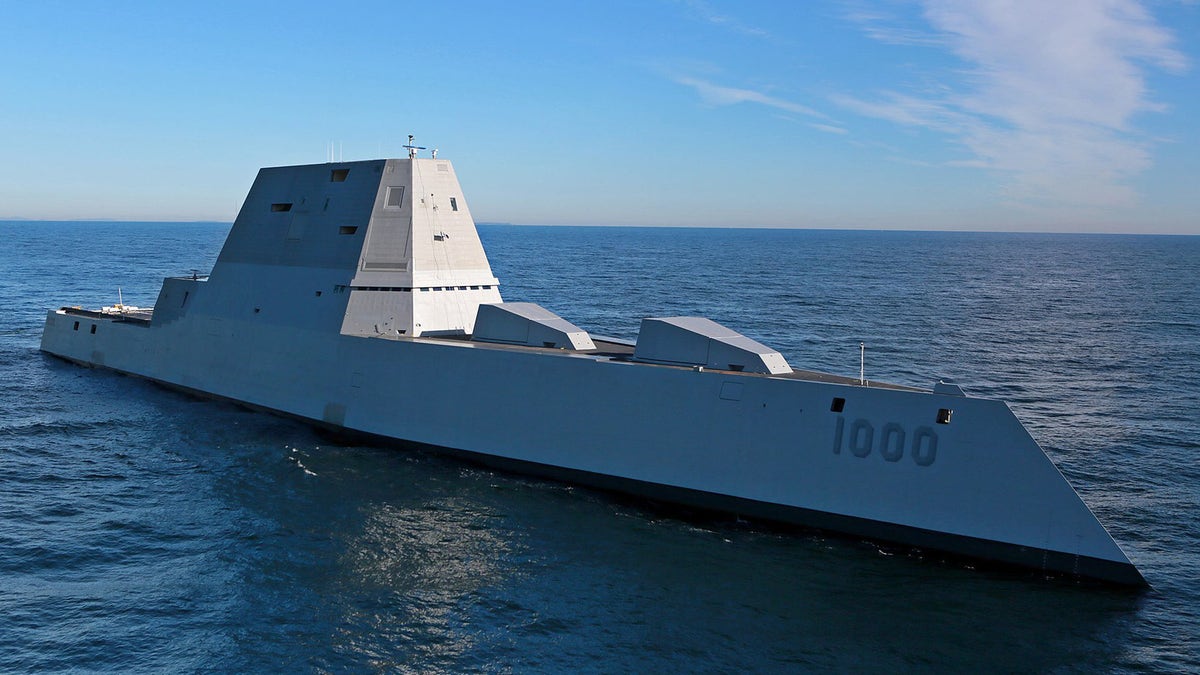
The USS Zumwalt - file photo (U.S. Navy)
When faced with high winds, up to 20-foot waves and dangerously rough seas, which Navy ships can survive -- and continue to wage war on the open sea?
Would the new stealthy USS Zumwalt destroyer capsize or suffer extreme damage if its wave-piercing Tumblehome hull were subject to massively dangerous stormy sea conditions?
Such questions, often put to the test with new ships during “sea-trials,” were of particular relevance with the Zumwalt, as it is a first-in-class high-tech warship built with a sleek, more linear, stealthy hull. There have been persistent questions as to whether the ship might have stability problems in dangerous sea states, given that it does not have a standard “flare” shaped hull used by most destroyers and carriers. Rather, it has a thinner, sharper, smaller wave-piercing hull intended to increase stealth, maneuverability and speed.
NAVY MAY ARM NEW DESTROYER WITH CONVENTIONAL MISSILE ABLE TO HIT ANYWHERE ON EARTH IN AN HOUR
The answer, according to the Commanding Officer of the USS Zumwalt Capt. Andrew Carlson is that the ship has remarkable, if even somewhat surprising, stability.
“We took advantage of a Gulf of Alaska storm which reached Sea State 6 conditions. We were able to drive around in that at full power,” he said during a presentation at the Surface Navy Association Symposium in Arlington, Va. “I had some hesitations and I knew the ship rode differently, but I would rather ride this ship in heavy seas.
Sea State is a World Meteorological Organization Standard specifying 13 - to 20-foot waves and rough seas.
NAVY STRATEGY FAST-TRACKS NEW WEAPONS FOR 'OFFENSIVE' ATTACK
Carson explained that, while the rough seas were as always nerve-racking, the ship seemed to “come back” from a roll caused by extremely rough seas. He said that during the heavy storm, “green water waves were coming up on the bow.”
“You get used to the roll period. It is short. If you are working on top on a cruiser in rough seas, you wonder if you are going to come back [roll back flat in rough seas]. With Zumwalt, we don’t experience that. You get used to finer oscillations,” Carlson said.
Carlson, who said the Navy still has work to do assessing and preparing the ship for war, said “these sorts of lessons quiet the anxiety.”
NAVY ACCELERATES NEW SHIP RADAR TO SUPPORT EMERGING 'SEA-ATTACK' STRATEGY
The much-analyzed Tumblehome hull is a smooth, stealthy, linear type of hull engineered to slice through the waves. It is designed to not only help the ship achieve greater speed and maneuverability but also intended to increase the ship’s stealthy characteristics. A smaller mass beneath the water naturally reduces any kind of acoustic return signal to enemy sonar. While not likely to remain completely undetectable at certain ranges with certain kinds of sonar, the ship’s surface and undersea configuration is reported to massively change any kind of radar or sonar return signal -- potentially confusing potential adversaries as to the actual nature of the ship. At one point earlier in the ship’s development, Naval Sea Systems Command reported that the USS Zumwalt appeared as a “small fishing boat” to enemy radar.
There may be some interesting reasons why the Zumwalt can perform well in rough seas, based upon an analysis of the topic in an essay by author Christopher Bassler from the Seakeeping Division, Naval Surface Warfare Center, Carderock Division.
The paper, called “Dynamic Stability of Flared and Tumblehome Hull Forms in Waves,” specifically takes up a precise comparison between Tumblehome hulls and what it calls Flared, or more traditional hulls.
'FIRST-CUT-OF-STEEL' BEGINS NEW ERA IN NUCLEAR WEAPONS, SUBMARINE WARFARE
According to a preliminary series of tests outlined in the paper, the Tumblehome hull did experience a greater capsize rate in some sea states, particularly in extremely high seas such as Sea State 8. However, the study says the Tumblehome hull can reduce its number of capsizes by extending or elongating the area of centered, balanced weight distribution.
“From the random seas investigation, a significant difference was observed for the capsize rate of the flared and Tumblehome topside geometries. To achieve a similar, reduced number capsizes the GM (KG-Centre of Gravity) of the Tumblehome topside must be increased by 1- 1.5m,” the essay writes.
CLICK HERE TO GET THE FOX NEWS APP
The ship appears to have been engineered with a carefully distributed center of gravity to minimize the chance of capsizing. A ship’s center of gravity is defined as “the point where the total weight force of the ship is considered to act vertically downwards.” More generally, a ship’s center of gravity is the point at which the entire weight of the ship is concentrated such that -- if supported at that point -- the body remains in equilibrium.
